The Use of an Orographic Precipitation Model to Assess the Precipitation Spatial Distribution in Lake Kinneret Watershed
Abstract
:1. Introduction
2. Literature Review
2.1. Rainfall over North Israel
2.2. Atmospheric Model Studies in the Region
2.3. Orographic Precipitation Model (OPM)
3. Study Area, Data and Initial Analysis
3.1. Lake Kinneret Watershed
3.2. In-Situ Data
3.3. Global Hydro Estimator (GHE)
3.4. Climate Forecast System Version 2 (CFSv2) and Reanalysis (CFSR)
3.5. The Selected Rainfall Events
3.6. Radiosonde Analysis
4. The Orographic Precipitation Model (OPM)
4.1. Model Structure and the Key Assumptions
4.2. Orographic Model Set Up and Parameters Estimation
5. Results and Discussion
5.1. OPM Simulations Comparison with Gauge and GHE
5.2. Rainfall Estimates for the Upper Watershed (Mt. Hermon)
6. Conclusions and Prospect
Acknowledgments
Author Contributions
Conflicts of Interest
References
- Daly, C.; Neilson, R.P.; Phillips, D.L. A statistical-topographic model for mapping climatological precipitation over mountainous terrain. J. Appl. Meteorol. 1994, 33, 140–158. [Google Scholar] [CrossRef]
- Groisman, P.Y.; Legates, D.R. The accuracy of United States precipitation data. Bull. Am. Meteorol. Soc. 1994, 75, 215–227. [Google Scholar] [CrossRef]
- Sade, R.; Rimmer, A.; Litaor, I.M.; Shamir, E.; Furman, A. Snow surface energy and mass balance in a warm temperate climate mountain. J. Hydrol. 2014, 519, 848–862. [Google Scholar] [CrossRef]
- Germann, U.; Joss, J. Variograms of radar reflectivity to describe the spatial continuity of Alpine precipitation. J. Appl. Meteorol. 2001, 40, 1042–1059. [Google Scholar] [CrossRef]
- Zangl, G.; Aulehner, D.; Wastl, C.; Pfeiffer, A. Small-scale precipitation variability in the Alps: Climatology in comparison with semi-idealized numerical simulations. Q. J. R. Meteorol. Soc. 2008, 134, 1865–1880. [Google Scholar] [CrossRef]
- Wang, J.; Georgakakos, K.P. Validation and sensitivities of dynamic precipitation simulation for winter events over the Folsom Lake watershed: 1964–1999. Mon. Weather Rev. 2005, 133, 3–19. [Google Scholar] [CrossRef]
- Smith, R.B. The influence of mountains on the atmosphere. Adv. Geophys. 1979, 21, 87–230. [Google Scholar]
- Gutmann, E.; Barstad, I.; Clark, M.; Arnold, J.; Rasmussen, R. The intermediate complexity atmospheric research model (ICAR). J. Hydrometeorol. 2016, 17, 957–973. [Google Scholar] [CrossRef]
- Wayand, N.E.; Hamlet, A.F.; Hughes, M.; Feld, S.I.; Lundquist, J.D. Intercomparison of meteorological forcing data from empirical ad mesoscale model sources in the North Fork American River Basin in Northern Sierra Nevada, California. J. Hydrometeorol. 2013, 14, 677–699. [Google Scholar] [CrossRef]
- Watson, C.D.; Lane, T.P. Sensitivities of orographic precipitation to terrain geometry and upstream conditions in idealized simulations. J. Atmos. Sci. 2012, 69, 1208–1231. [Google Scholar] [CrossRef]
- Kunz, M. Characteristics of large-scale orographic precipitation in a linear perspective. J. Hydrometeorol. 2011, 12, 27–43. [Google Scholar] [CrossRef]
- Barstad, I.; Shuller, F. An extension of Smith’s linear theory of orographic precipitation; Introduction of vertical layers. J. Atmos. Sci. 2011, 68, 2695–2709. [Google Scholar] [CrossRef]
- Wetzel, M.; Meyers, M.; Borys, R.; McAnelly, R.; Cotton, W.; Rossi, A.; Frisbie, P.; Nadler, D.; Lowenthal, D.; Cohn, S.; et al. Mesoscale Snowfall Prediction and Verification in Mountainous Terrain. Weather Forecast. 2003, 19, 806–828. [Google Scholar] [CrossRef]
- Jimenez, P.A.; Dudhia, J. Improving the representation of resolved and unresolved topographic effects on surface wind in the WRF model. J. Appl. Meteorol. Clim. 2012, 51, 300–316. [Google Scholar] [CrossRef]
- Sindosi, O.A.; Bartzokas, A.; Kotroni, V.; Lagouvardos, K. Influence of orography on precipitation amount and distribution in NW Greece: A case study. Atmos. Res. 2015, 152, 105–122. [Google Scholar] [CrossRef]
- Wilson, A.M.; Barros, A.P. Landform controls on low-level moisture convergence and the diurnal cycle of warm season orographic rainfall in the Southern Appalachians. J. Hydrol. 2015, 531, 475–493. [Google Scholar] [CrossRef]
- Scheffknecht, P.; Richard, E.; Lambert, D. A highly localized high precipitation event over Corsica. Q. J. R. Meteorol. Soc. 2016, 142, 206–221. [Google Scholar] [CrossRef]
- Georgakakos, K.P.; Graham, N.E.; Modrick, T.M.; Murphy, M., Jr.; Shamir, E.; Spencer, C.; Sperfslage, J.A. Evaluation of real-time hydrometeorological ensemble prediction on hydrologic scales in Northern California. J. Hydrol. 2014, 519, 2978–3000. [Google Scholar] [CrossRef]
- Rimmer, A.; Givati, A. Hydrology. Chapter 7. In Lake Kinneret: Ecology and Management; Zohary, T., Sukenik, A., Berman, T., Nishri, A., Eds.; Springer: Heidelberg, Germany, 2014. [Google Scholar]
- Zangvil, A.; Druian, P. Upper Air Trough Axis Orientation and the Spatial-Distribution of Rainfall over Israel. Int. J. Climatol. 1990, 10, 57–62. [Google Scholar] [CrossRef]
- Goldreich, Y. The Climate of Israel: Observation, Research and Application; Kluwer Academic/Plenum Publishers: New York, NY, USA, 2003; p. 270. [Google Scholar]
- Saaroni, H.; Halfon, N.; Ziv, B.; Alpert, P.; Kutiel, H. Links between the rainfall regime in Israel and location and intensity of Cyprus lows. Int. J. Climatol. 2010, 30, 1014–1025. [Google Scholar] [CrossRef]
- Ziv, B.; Saaroni, H.; Romem, M.; Heifetz, E.; Harnik, N.; Baharad, A. Analysis of Conveyor Belts in Winter Mediterranean Cyclones. Theor. Appl. Climatol. 2010, 99, 441–455. [Google Scholar] [CrossRef]
- Lionello, P. The Climate of the Mediterranean Region, from the Past to the Future, 1st ed.; Elsevier: Amsterdam, The Netherlands, 2012. [Google Scholar]
- Shay-El, Y.; Alpert, P. A diagnostic study of winter diabatic heating in the Mediterranean in relation with cyclones. Q. J. R. Meteorol. Soc. 1991, 117, 715–747. [Google Scholar] [CrossRef]
- Alpert, P.; Osetinsky, I.; Ziv, B.; Shafir, H. Semi-objective classification for daily synoptic systems: Application to the Eastern Mediterranean climate change. Int. J. Climatol. 2014, 24, 1001–1011. [Google Scholar] [CrossRef]
- Goldreich, Y.; Mozes, H.; Rosenfeld, D. Radar analysis of cloud systems and their rainfall yield, in Israel. Isr. J. Earth Sci. 2004, 53, 63–76. [Google Scholar] [CrossRef]
- Alpert, P.; Neeman, B.U.; Shay-El, Y. Climatological analysis of Mediterranean cyclones using ECMWF data. Tellus 1990, 42, 65–77. [Google Scholar] [CrossRef]
- Peleg, N.; Morin, E. Convective rain cells: Radar derived spatiotemporal characteristics and synoptic patters over eastern Mediterranean. J. Geophys. Res. 2012, 117, 1–17. [Google Scholar] [CrossRef]
- Rosenfeld, D. Dynamic Characteristics of Cumuliform Clouds and Cloud Systems and their Influence on Rainfall. Ph.D. Thesis, Hebrew University of Jerusalem, Jerusalem, Israel, 1986. [Google Scholar]
- Kahana, R.; Ziv, B.; Enzel, Y.; Dayan, U. Synoptic climatology of major floods in the Negev Desert, Israel. Int. J. Climatol. 2002, 22, 867–882. [Google Scholar] [CrossRef]
- Katsnelson, J. The variability of annual precipitation in Palestine. Arch. Meteorol. Geophys. Bioklimatol. 1964, 13, 163–172. [Google Scholar] [CrossRef]
- Kutiel, H. Rainfall variations in the Galilee (Israel). I. Variations in the spatial distribution in the periods 1931–1960 and 1951–1980. J. Hydrol. 1987, 94, 331–344. [Google Scholar] [CrossRef]
- Ziv, B.; Shilo, E.; Rimmer, A. Meteorology. Chapter 6. In Lake Kinneret—Ecology and Management; Zohary, T., Sukenik, A., Berman, T., Nishri, A., Eds.; Springer: The Netherlands, 2014; pp. 81–97. [Google Scholar]
- Gilad, D.; Schwartz, S. Hydrogeology of the Jordan sources aquifers. Isr. Hydrol. Ser. Rep. Hydrol. 1978, 58, 5–78. (In Hebrew) [Google Scholar]
- Simpson, B.; Carmi, I. The hydrology of the Jordan tributaries (Israel) hydrographic and isotopic investigation. J. Hydrol. 1983, 62, 225–242. [Google Scholar] [CrossRef]
- Gur, D.; Bar-Matthews, M.; Sass, E. Hydrochemisty of the main Jordan River sources: Dan, Banias, and Kezinim springs, north Hula Valley, Israel. Isr. J. Earth Sci. 2003, 52, 155–178. [Google Scholar] [CrossRef]
- Rimmer, A.; Salingar, Y. Modelling precipitation-streamflow processes in Karst basin: The case of the Jordan River sources, Israel. J. Hydrol. 2006, 331, 524–542. [Google Scholar] [CrossRef]
- Halfon, N.; Kutiel, H. Changes in the spatial and temporal characteristics of rainfall in Northern Israel and their meaning. Horiz. Geogr. 2004, 62, 33–42. (In Hebrew) [Google Scholar]
- Alpert, P.; Shafir, H. A physical model to complement rainfall normal over complex terrain. J. Hydrol. 1989, 110, 51–62. [Google Scholar] [CrossRef]
- Isakson, A. Rainfall distribution over central and southern Israel induced by large-scale moisture flux. J. Appl. Meteorol. 1996, 35, 1063–1075. [Google Scholar] [CrossRef]
- Givati, A.; Lynn, B.; Liu, Y.; Rimmer, A. Coupling high-resolution WRF with a hydrological model for operational prediction of Jordan River stream flow. J Appl. Meteorol. Climatol. 2012, 51, 285–299. [Google Scholar] [CrossRef]
- Rostkier-Edelstein, D.; Liu, Y.; Wu, W.; Kunin, P.; Givati, A.; Ge, M. Towards a high-resolution climatography of seasonal precipitation over Israel. Int. J. Climatol. 2014, 34, 1964–1979. [Google Scholar] [CrossRef]
- Saha, S.; Moorthi, S.; Pan, H.L.; Wu, X.; Wang, J.; Nadiga, S.; Tripp, P.; Kistler, R.; Woollen, J.; Behringer, D.; et al. The NCEP Climate Forecast System Reanalysis. Bull. Am. Meteorol. Soc. 2010, 90, 1015–1057. [Google Scholar] [CrossRef]
- Rimmer, A.; Givati, A.; Samuels, R.; Alpert, P. Using ensemble of climate models to evaluate future water and solutes budgets in Lake Kinneret, Israel. J. Hydrol. 2011, 410, 248–259. [Google Scholar] [CrossRef]
- Smiatek, G.; Kunstmann, H.; Heckl, A. High-resolution climate change simulations for the Jordan River area. J. Geophys. Res. 2011, 116. [Google Scholar] [CrossRef]
- Smiatek, G.; Kunstmann, H.; Heckl, A. High-Resolution Climate Change Impact Analysis on Expected Future Water Availability in the Upper Jordan Catchment and the Middle East. J. Hydrometeorol. 2014, 15, 1517–1531. [Google Scholar] [CrossRef]
- Hydrologic Research Center-Georgia Water Resources Institute (HRC-GWRI). Integrated Forecast and Reservoir Management (INFORM) for Northern California: System Development and Initial Demonstration; PIER Energy-Related Environmental Research, CEC-500-2006-109, 244pp + 9 Appendices; California Energy Commission: Sacramento, CA, USA, 2007.
- Hydrologic Research Center-Georgia Water Resources Institute (HRC-GWRI). Implications of Climatic Changes for Northern California Water Resources Management for the Later Part of the 21st Century; PIER Energy-Related Environmental Research, Final Report, Award No. 500-07-013; California Energy Commission: Sacramento, CA, USA, 2010; p. 114.
- Hydrologic Research Center-Georgia Water Resources Institute (HRC-GWRI). INFORM Enhancement and Demonstration Results for Northern California (2008–2012); PIER Energy-Related Environmental Research, Publication # CEC-500-2014-019, 224pp. + 6 Appendices; California Energy Commission: Sacramento, CA, USA, 2014.
- Georgakakos, K.P.; Graham, N.E.; Cheng, F.Y.; Spencer, C.; Shamir, E.; Georgakakos, A.P.; Yao, H.; Kistenmacher, M. Value of adaptive water resources management in northern California under climatic variability and change: Dynamic hydroclimatology. J. Hydrol. 2012, 412, 47–65. [Google Scholar] [CrossRef]
- Georgakakos, A.P.; Yao, H.; Kistenmacher, M.; Georgakakos, K.P.; Graham, N.E.; Cheng, F.Y.; Spencer, C.; Shamir, E. Value of adaptive water resources management in northern California under climatic variability and change: Reservoir Management. J. Hydrol. 2012, 412, 34–46. [Google Scholar] [CrossRef]
- Carpenter, T. An Interdisciplinary Approach to Characterize Flash Flood Occurrence Frequency for Mountainous Southern California. Ph.D. Thesis, Scripps Institution of Oceanography, University of California, San Diego, CA, USA, 2011. [Google Scholar]
- Georgakakos, K.P.; Sperfslage, J.A.; Tsintikidis, D.; Carpenter, T.M.; Krajewski, W.F.; Kruger, A. Design and Tests of an Intergrated Hydrometeorological Forecast System for the Operational Estimation and Forecasting of Rainfall and Streamflow in the Mountainous Panama Canal watershed; HRC Technical Report No. 2; Hydrologic Research Center: San Diego, CA, USA, 1999. [Google Scholar]
- Georgakakos, K.P.; Sperfslage, J.A. Operational Rainfall and Flow Forecasting for the Panama Canal Watershed. In The Río Chagres, Panama; Harmon, R.S., Ed.; Water Science and Technology Library; Springer: Dordrecht, The Netherlands, 2005; pp. 325–335. [Google Scholar]
- Sharon, D.; Kutiel, H. The distribution of rainfall intensity in Israel, its regional and seasonal variation and its climatological evaluation. J. Climatol. 1986, 6, 277–291. [Google Scholar] [CrossRef]
- Mhawej, M.; Faour, G.; Fayad, A.; Shaban, A. Towards an enhanced method to map snow cover areas and derive snow-water equivalent in Lebanon. J. Hydrol. 2014, 513, 274–282. [Google Scholar] [CrossRef]
- Asmael, N.M.; Dupuy, A.; Huneau, F.; Hamid, S.; Coustumer, P.L. Groundwater Modeling as an Alternative Approach to Limited Data in the Northeastern Part of Mt. Hermon (Syria), to Develop a Preliminary Water Budget. Water 2015, 7, 3978–3996. [Google Scholar] [CrossRef]
- Shamir, E.; Georgakakos, K.P.; Spencer, C.; Modrick, T.M.; Murphy, M.J., Jr.; Jubach, R. Evaluation of real-time flash flood forecasts for Haiti during the passage of Hurricane Tomas, 4–6 November, 2010. Nat. Hazards 2013, 67, 459–482. [Google Scholar] [CrossRef]
- Modrick, M.T.; Graham, R.; Shamir, E.; Jubach, R.; Spencer, C.; Sperfslage, J.A.; Georgakakos, K.P. Operational Flash Flood Warning Systems with Global Applicability. In Proceedings of the 7th International Congress on International Environmental Modelling and Software Society, San Diego, CA, USA, 15–19 June 2014.
- Scofield, R.A.; Kuligowski, R.J. Status and outlook of operational satellite precipitation algorithms for extreme-precipitation events. Mon. Weather Rev. 2003, 18, 1037–1051. [Google Scholar] [CrossRef]
- Vicente, G.A.; Scofield, R.A.; Menzel, W.P. The operational GOES infrared rainfall estimation technique. Bull. Am. Meteorol. Soc. 1998, 79, 1883–1898. [Google Scholar] [CrossRef]
- Vicente, G.A.; Davenport, J.C.; Scofield, R.A. The role of orographic and parallax corrections on real time high-resolution satellite rainfall estimation. Int. J. Remote Sens. 2002, 23, 221–230. [Google Scholar] [CrossRef]
- Modrick, M.T.; Georgakakos, K.P.; Shamir, E.; Spencer, C. Operational quality control of radar data to support regional flash flood warning systems. J. Hydrol. Eng. 2016. [Google Scholar] [CrossRef]
- Saha, S.; Moorthi, S.; Wu, X.; Wang, J.; Nadiga, S.; Tripp, P.; Behringer, D.; Hou, Y.T.; Chuang, H.Y.; Iredell, M.; et al. The NCEP climate forecast system version 2. J. Clim. 2014, 27, 2185–2208. [Google Scholar] [CrossRef]
- Wu, W.; Liu, Y.; Ge, M.; Rostkier-Edelstein, D.; Descombes, G.; Kunin, P.; Warner, T.; Swerdlin, S.; Givati, A.; Hopson, T.; et al. Statistical downscaling of climate forecast system seasonal predictions for the Southeastern Mediterranean. Atmos. Res. 2012, 118, 346–356. [Google Scholar] [CrossRef]
- Rostkier-Edelstein, D.; Kunin, P.; Hopson, T.M.; Liu, Y.; Givati, A. Statistical downscaling of seasonal precipitation in Israel. Int. J. Climatol. 2016, 36, 590–606. [Google Scholar] [CrossRef]
- Georgakakos, K.P. Hydrometeorological models for real time rainfall and flow forecasting. In Mathematical Models of Small Watershed Hydrology and Applications; Singh, V.P., Frevert, D.K., Eds.; Water Resources Publication: Highlands Ranch, CO, USA, 2002; Volume 2. [Google Scholar]
- Pandey, G.R.; Cayan, D.R.; Dettinger, M.D.; Georgakakos, K.P. A hybrid orographic plus statistical model for downscaling daily precipitation in Northern California. J. Hydroclimatol. 2000, 1, 491–506. [Google Scholar] [CrossRef]
- Rhea, J.O. Orographic Precipitation Model for Hydrometeorological Use. Ph.D. Thesis, Colorado State University, Fort Collins, CO, USA, 1978. [Google Scholar]
- Peterson, T.C.; Grant, L.O.; Cotton, W.R.; Rogers, D.C. The effect of decoupled low-level flow on winter orographic clouds and precipitation in Yampa River Valley. J. Appl. Meteorol. 1991, 30, 368–386. [Google Scholar] [CrossRef]
- Kessler, E. On the Distribution and Continuity of Water Substance in Atmospheric Circulation; American Meteorological Society: Boston, MA, USA, 1969; p. 84. [Google Scholar]
- Kessler, E. Model of precipitation and vertical air currents. Tellus 1974, 26, 519–542. [Google Scholar] [CrossRef]
- Tsikinidis, D.; Georgakakos, K.P. Microphysical and large-scale dependencies of temporal rainfall variability over a tropical ocean. J. Atmos. Sci. 1999, 56, 724–748. [Google Scholar] [CrossRef]
- Georgakakos, K.P.; Krajewski, W.F. Statistical-microphysical causes of rainfall variability in the tropics. J. Geophys. Res. 1996, 101, 26165–26180. [Google Scholar] [CrossRef]
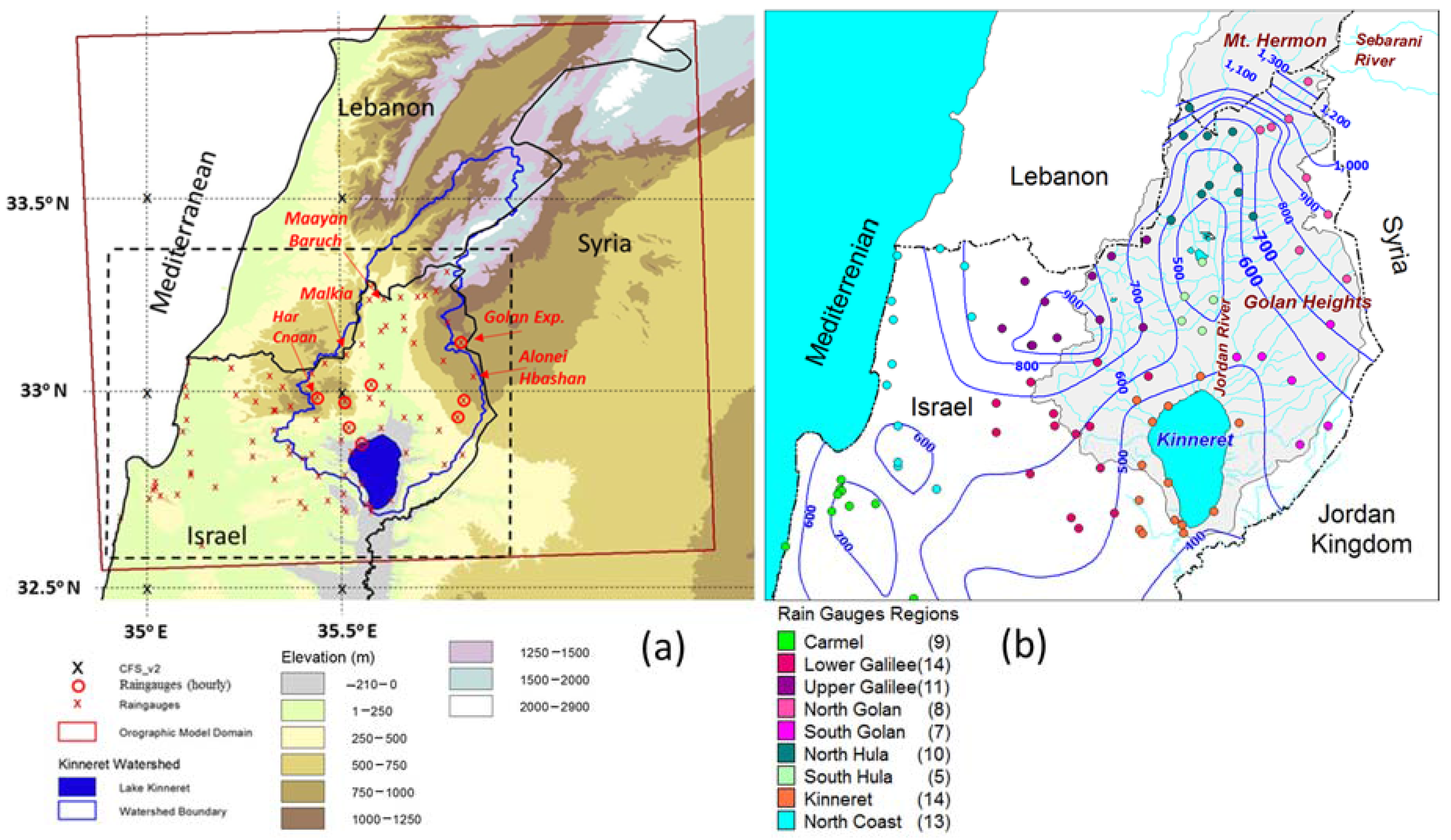
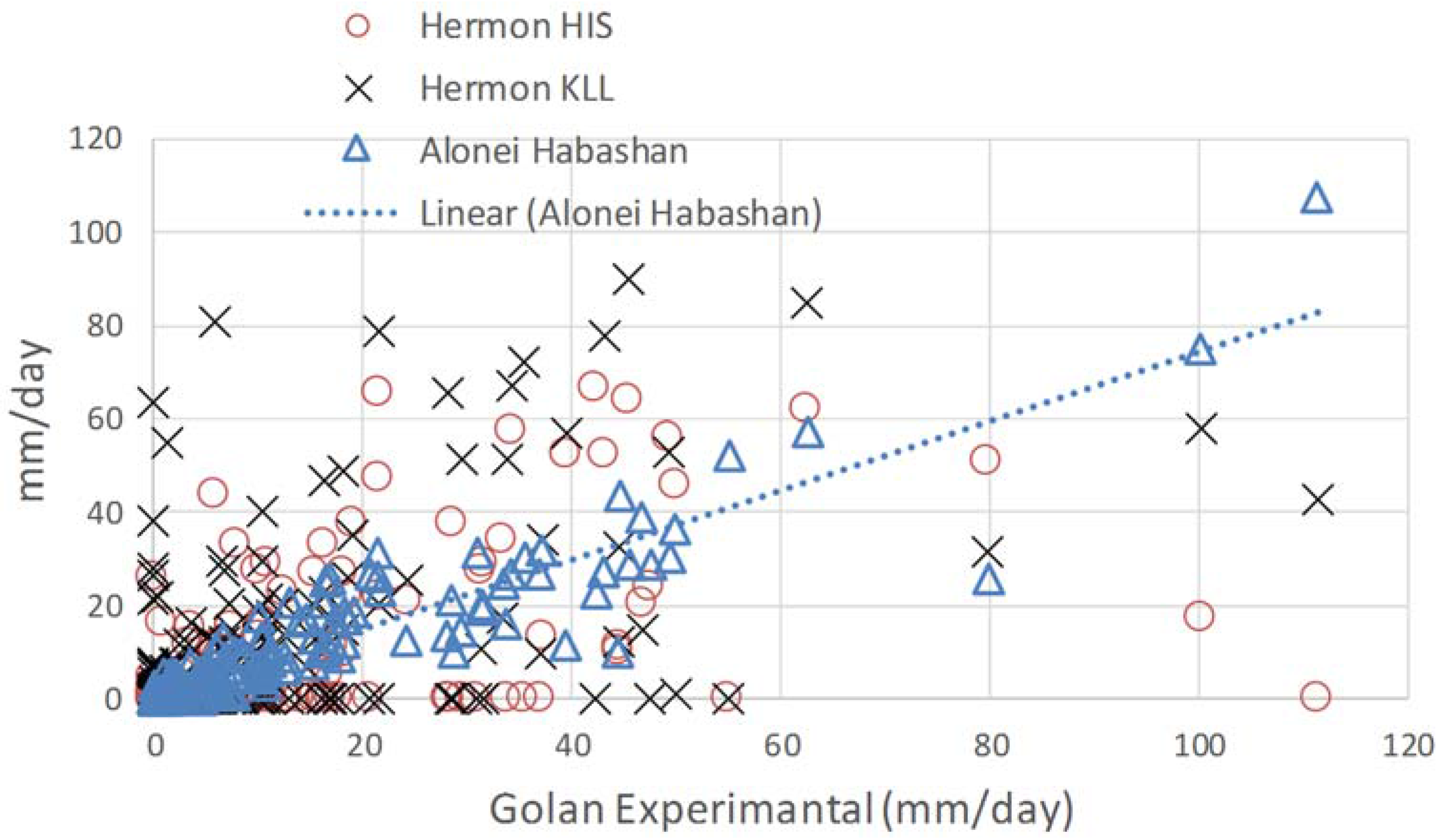
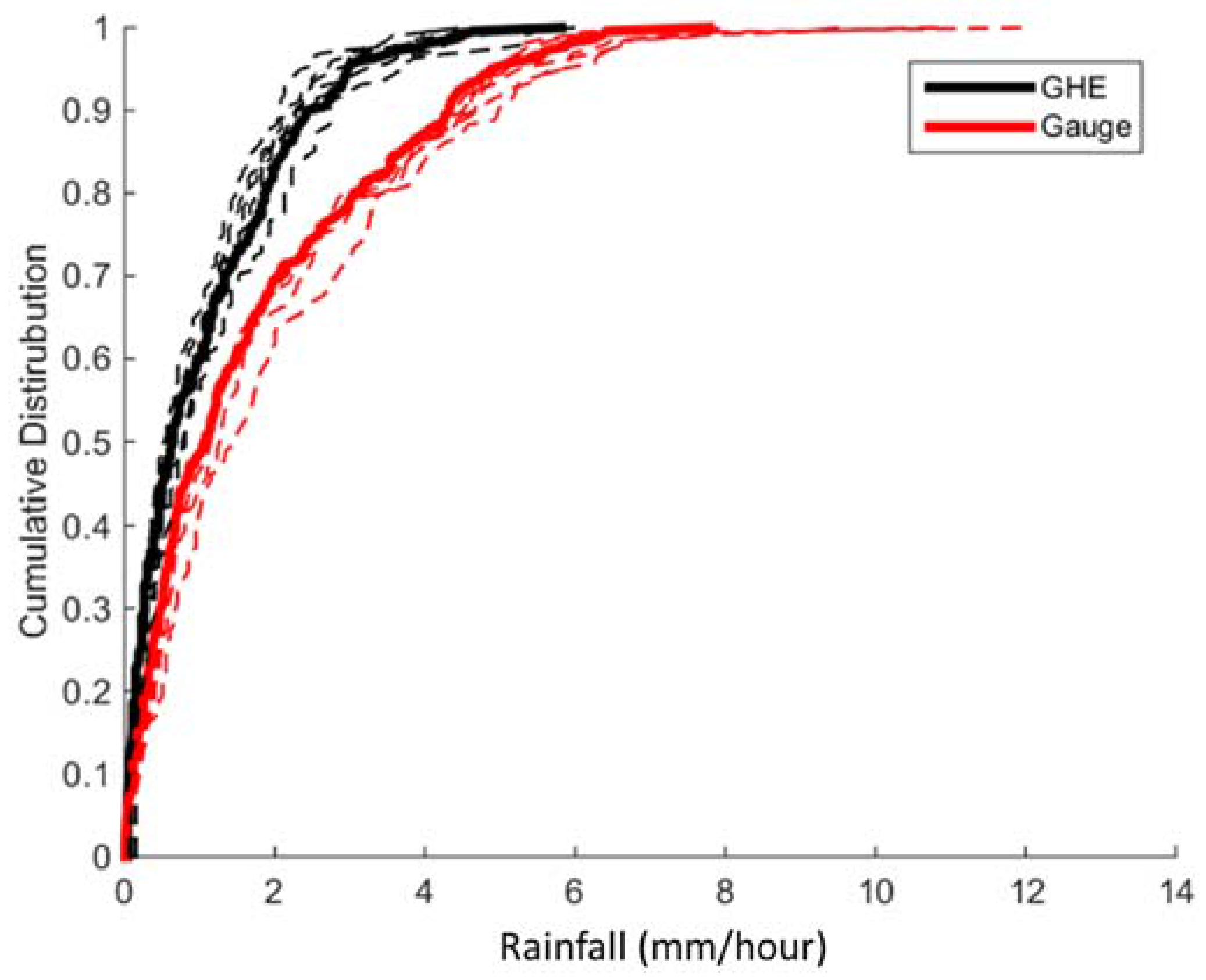
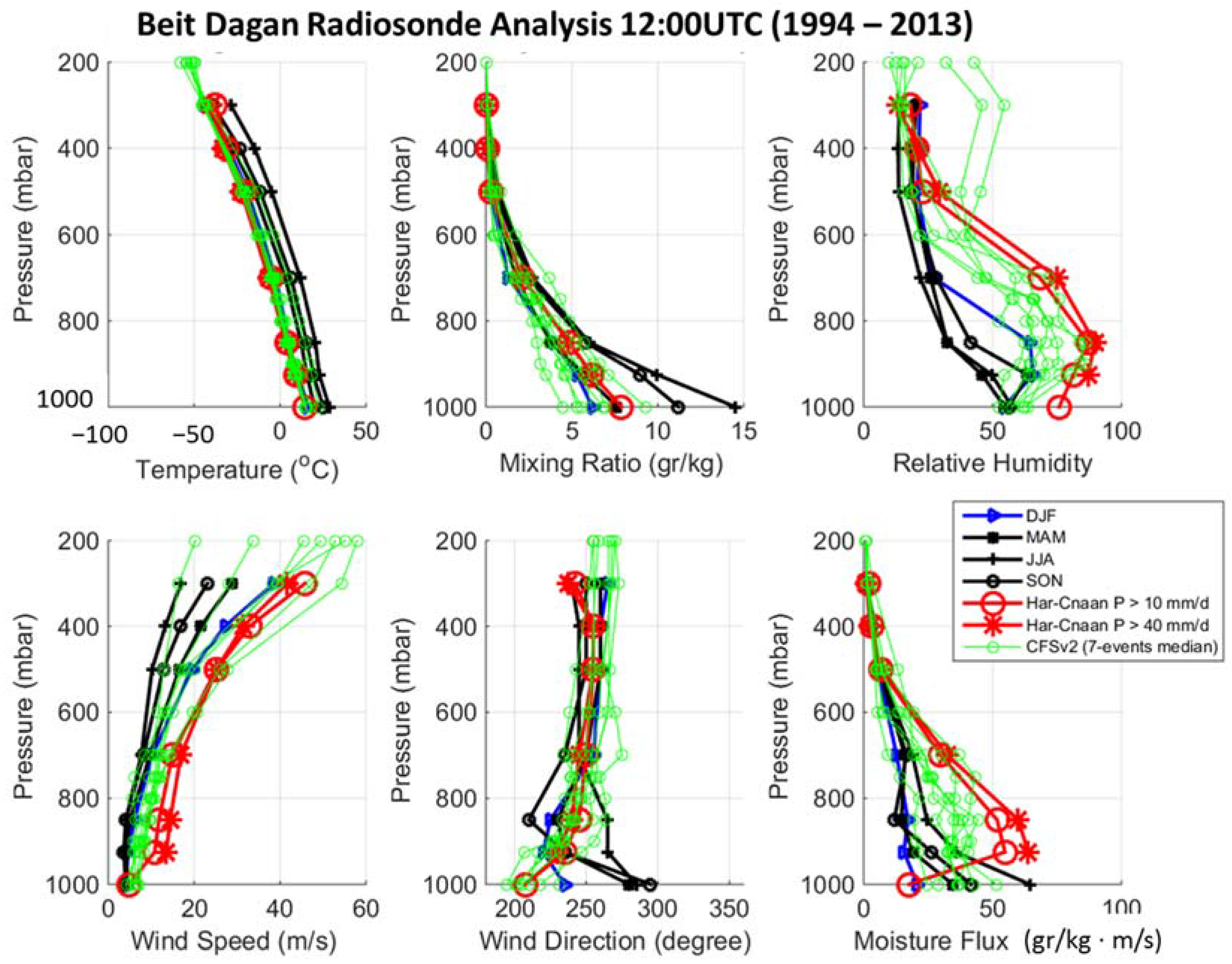
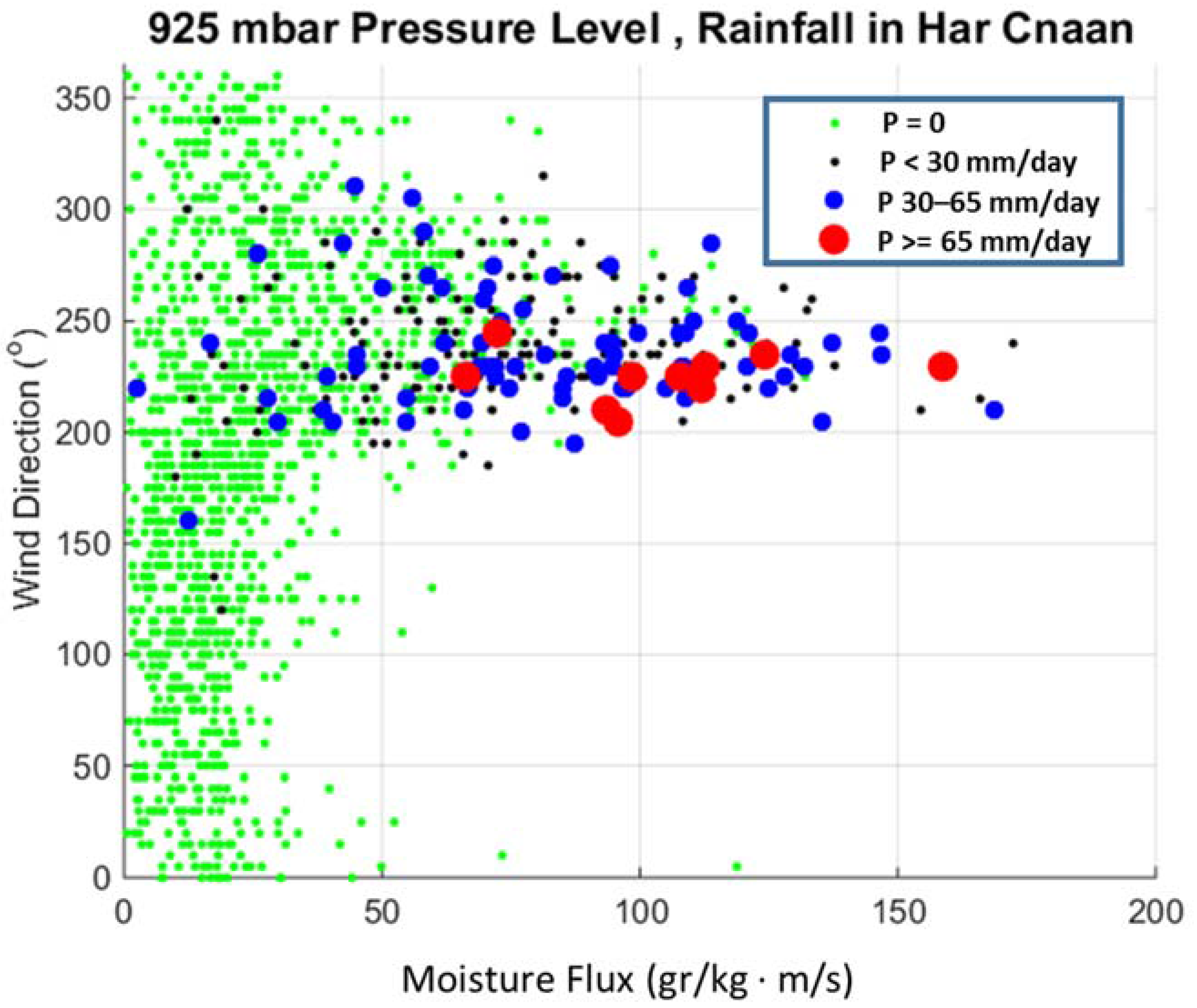

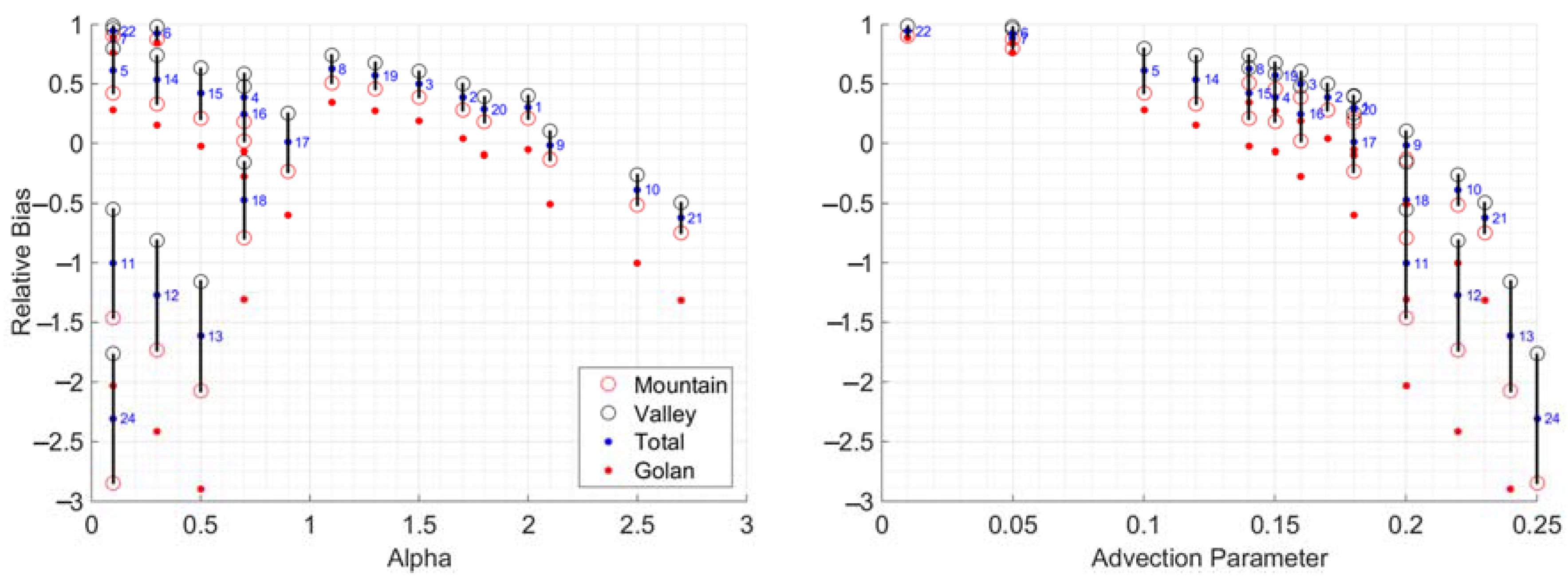


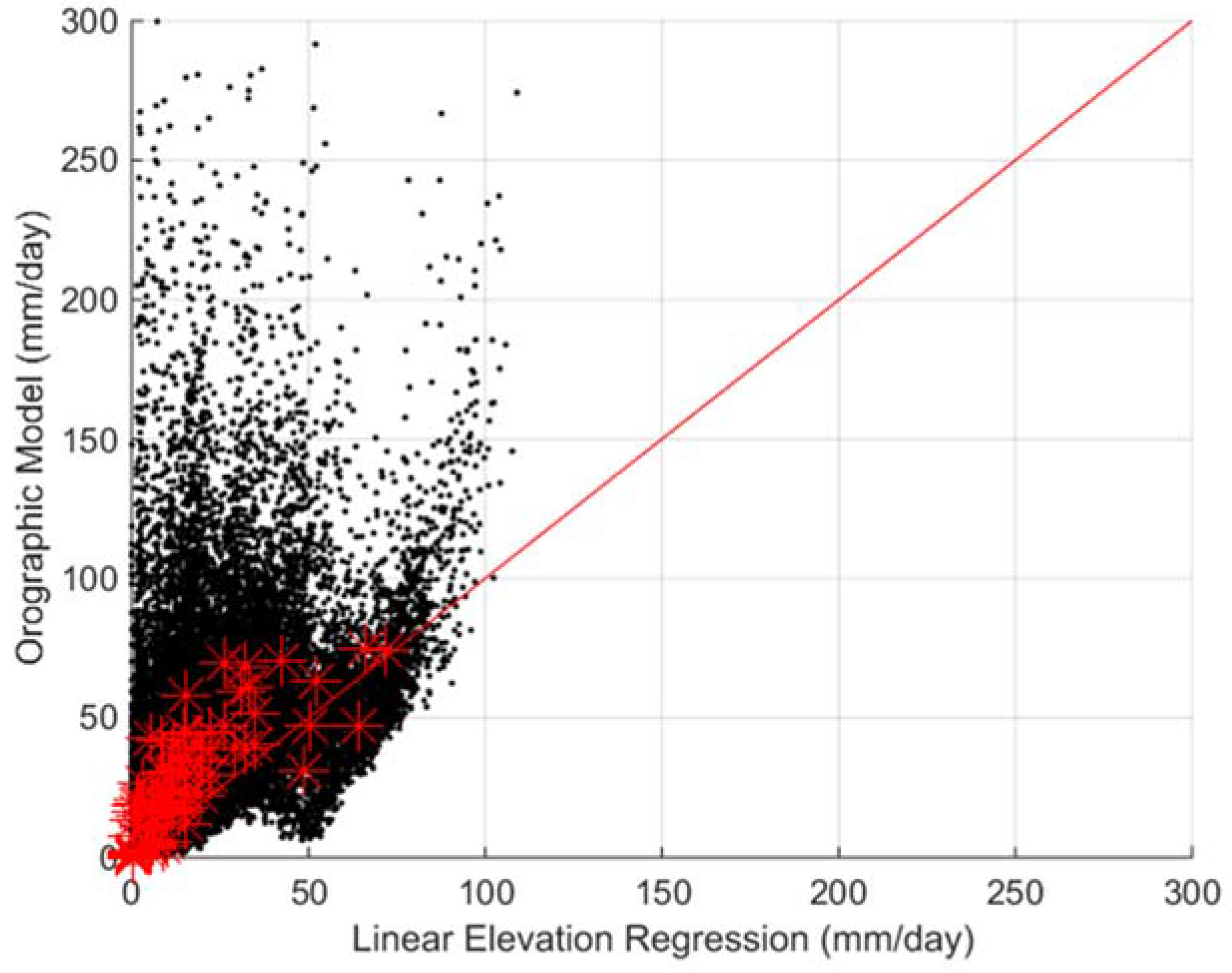
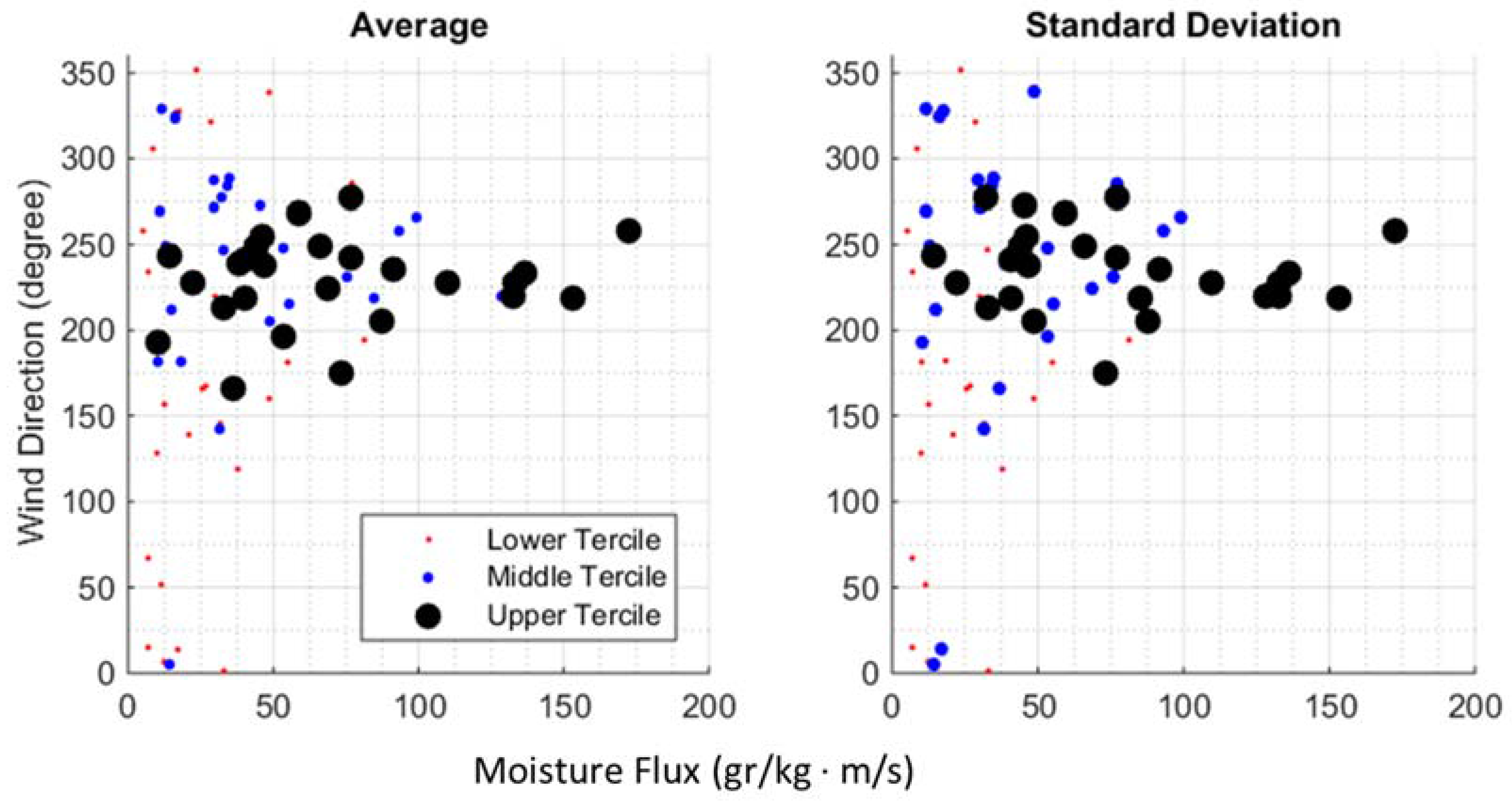

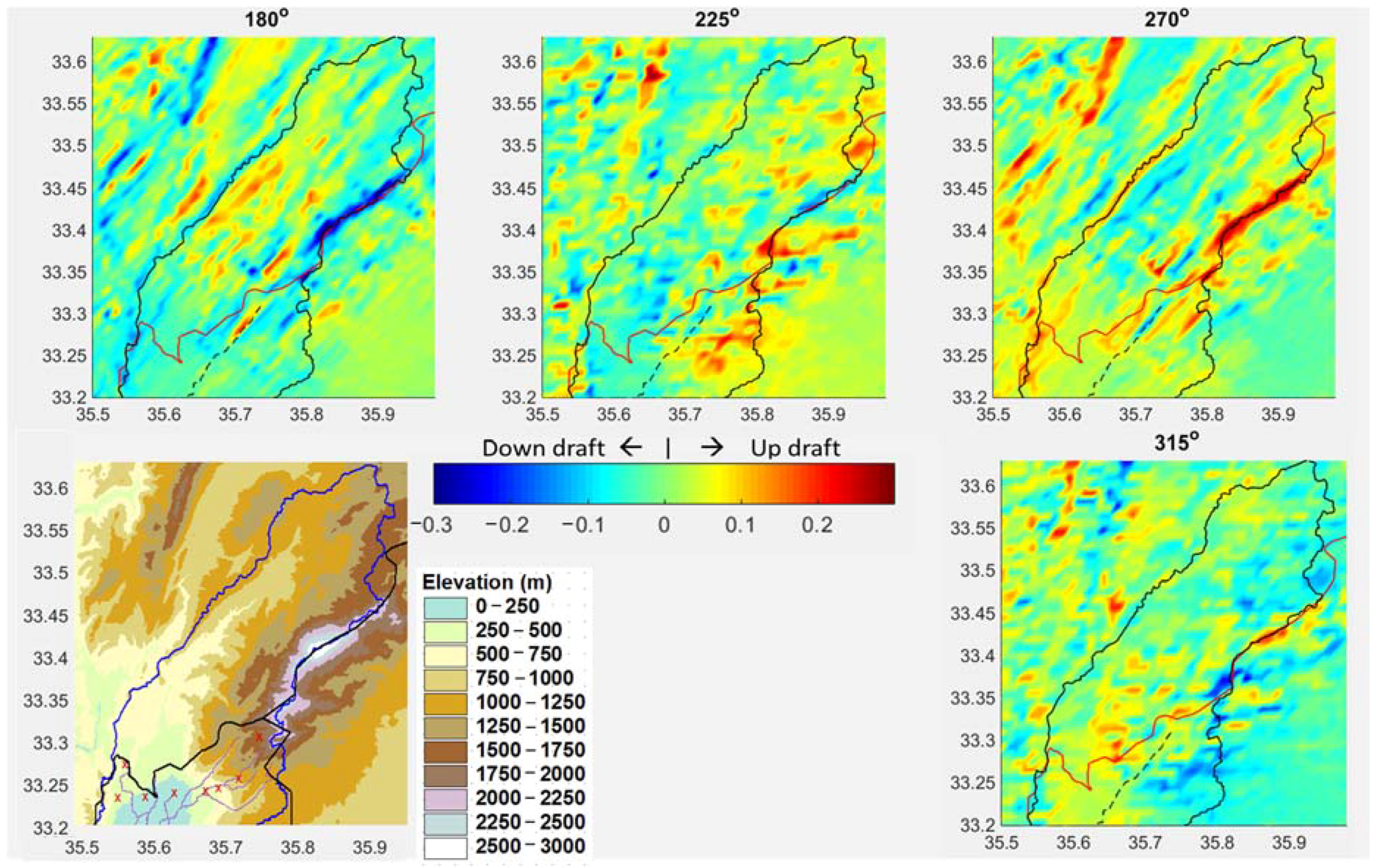
| Storm ID | Duration | Availability of GHE | Average Rainfall (mm·day−1) | Maximum Rainfall (mm·day−1) |
|---|---|---|---|---|
| 1 | 4–18 January 2012 | NO | 54 | 138 |
| 2 | 12–20 February 2012 | NO | 25 | 73 |
| 3 | 24 February–5 March 2012 | NO | 43 | 88 |
| 4 | 5–12 November 2012 | YES | 40 | 91 |
| 5 | 3–22 December 2012 | YES | 71 | 210 |
| 6 | 1–15 January 2013 | YES | 64 | 234 |
| 7 | 6–15 March 2014 | YES | 23 | 76 |
| Parameters | Values |
|---|---|
| Smoothing interpolation (km) | 25 |
| Wind level to compute free stream direction and velocity (mbars) | 850 |
| Number of atmospheric layers in the model (500 m intervals) | 14 |
| Wind speed threshold to allow orographic uplift (m/s) (α) | 2.5 |
| Weight for contribution of precipitation from mesoscale updraft to total precip | 0 |
| Weight for contribution of precipitation from orographic updrafts to total precip | 1 |
| Collection and coalescence efficiency (dimensionless) | 0.5 |
| Parameter in microphysical distribution | 1 × 107 |
| Auto conversion threshold (gr/m3) | 1.7 |
| Autoconversion parameter | 1 × 10−3 |
| Velocity scale height parameter | 0 |
| Minimum relative humidity at 925 hPa to engage mesoscale updraft (RHmin925) | 0.9 |
| Max orographic updraft threshold for mesoscale contribution to updraft (m/s) (β) | 0.17 |
© 2016 by the authors; licensee MDPI, Basel, Switzerland. This article is an open access article distributed under the terms and conditions of the Creative Commons Attribution (CC-BY) license (http://creativecommons.org/licenses/by/4.0/).
Share and Cite
Shamir, E.; Rimmer, A.; Georgakakos, K.P. The Use of an Orographic Precipitation Model to Assess the Precipitation Spatial Distribution in Lake Kinneret Watershed. Water 2016, 8, 591. https://doi.org/10.3390/w8120591
Shamir E, Rimmer A, Georgakakos KP. The Use of an Orographic Precipitation Model to Assess the Precipitation Spatial Distribution in Lake Kinneret Watershed. Water. 2016; 8(12):591. https://doi.org/10.3390/w8120591
Chicago/Turabian StyleShamir, Eylon, Alon Rimmer, and Konstantine P. Georgakakos. 2016. "The Use of an Orographic Precipitation Model to Assess the Precipitation Spatial Distribution in Lake Kinneret Watershed" Water 8, no. 12: 591. https://doi.org/10.3390/w8120591





